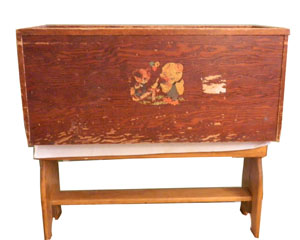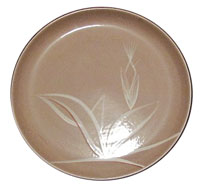 |
|
|||
 |
 |
|||
Copyright © Harry Rinker, LLC 2013 Questions
and Answers QUESTION: This past June, I purchased a handmade wooden toy box at a garage sale. The seller told me his grandfather was a carpenter by trade and made this for the seller’s mother. The chest measures 34in x 15in x 15”. There are screw holes in the back of the top that suggest the toy box once had a lid. The front has a decal of a bear on the left and a duck on the right. The left side features a decal of a bear, different from the one on the front, and the right side a duck. The decals suggest a late 1930s to 1950 origin. I want to sell the toy box in my antiques shop. Is this folk art? If yes, what is this worth? – RF, Hinckley, IL, Email Question ANSWER: The old maxim “you can’t make a silk purse out of sow’s ear” applies. While folk art is often crude and primitive in form and composition, it is not logical to assume, therefore, every object that is crude and primitive is folk art. After examining the pictures that accompanied your email, I reached the following conclusions. If the seller’s grandfather was a carpenter, he was a basic house carpenter and not a finishing carpenter or furniture maker. The toy box is basic four sides, a bottom, and lid construction. It could just as easily have been made by any individual who had a standard basement or garage workshop. Second, the decals are definitely late 1930s or 1940s. I recognize them from the cribs, high chairs, and other nursery accessories from that time period that I have seen in the field over the past 40 years. Third, the missing lid is the kiss-of-death in respect to value. The toy box is incomplete. Further, the cost to have a lid made and the required refinishing to restore the toy box to its period condition will exceed the final value by two to three times. Fourth, the Shabby Chic decorative look is in the distant past. As it stands, the toy chest has no collector value and minimum decorator or conversation value. Its novelty value is less than $50.00. Finally, the toy chest is not folk art. It has no aesthetic or design quality that transcends what it is. What you have is the remains of what was once a utilitarian, functional form that has outlived its usefulness. I will refrain from suggesting where I think it belongs. Since I began with a maxim, I will end with one: “beauty is in the eye of the beholder.” Hopefully, there is a beholder that sees more beauty in your toy chest than do I. 
QUESTION: My aunt was a Kennedy girl. She worked at the White House during his presidency. I have two Kennedy cigarette packs, two charcoal sketches, the first of Robert and the second of John, by an unidentified artist, and 35 PT 109 lapel pins. There are other items, but I cannot verify their legitimate connection to JFK. I would like to sell them but do not know what to ask. – ML, Marlborough, CT ANSWER: Hopefully, your aunt’s stay at the JFK White House was not as colorful as that of Mimi Alford, author of Once Upon a Secret: My Affair with President John F. Kennedy and its Aftermath. Kennedy cigarette packs and the PT 109 pins are commonly found items on the secondary market. Jim Burnt’s website http://www.jimsburntofferings.com/index.html contains a detailed history of presidential cigarette packs. The JFK White House cigarettes had a “White House” insert card placed on top of an ordinary pack of cigarettes. Dealers’ asking prices begin at $200.00 per pack. The asking price for PT 109 pins is between $75.00 and $95.00 depending on the variation. Of course, dealers do not pay anywhere near these prices to acquire these items. Further, dumping 35 pins into the market at one time will negatively impact prices. Depending on the quality of the artwork and the possibility that the artists can be identified, the highest value rests with the sketches. The difficulty is the lack of documentation. Were these sketches done while your aunt worked at the White House or later? Were they done by an amateur or professional artist? Normally, I would recommend that you have someone appraise your material. But, a skilled appraiser charges between $100.00 and $150.00 per hour. There is a possibility that you would pay more to have the collection appraised than it is worth. My recommendation is to contact Tom Slater, Director of Americana Auctions at Heritage Auctions in Dallas, Texas. He can be reached at 1-800-872-6467, ext. 1441. Although the end result may be your material is sold as one lot, you will maximize the potential for a good return and significantly reduce the amount of time you will have to spend disposing of the items.
ANSWER: Winfield Pottery, also listed as the Winfield Pottery/China Company, was founded in 1929. Originally located in Pasadena, California, Winfield Pottery moved to Santa Monica in 1946. In the same year, the American Ceramic Company, also located in Santa Monica, bought the rights to manufacture some of the Winfield patterns. Hence, American Ceramic Company’s “Gabriel” trademarked pieces are identical to Winfield pieces. Winfield Pottery ceased operations in 1962, one of the many victims of cheap foreign imports and the rising popularity of plastic dinnerware. The first thing to determine is whether your dinnerware service is made from earthenware (pottery) or porcelain. Hold a plate up to the light. If it is translucent (you can see light through it), it is porcelain. If not, it is glazed over earthenware. The use of “China” does not guarantee that the dinnerware is porcelain. An American Ceramic Products advertisement found on www.winfieldchina.com notes that Winfield China is: “VITRIFIED CHINA/ HAND-DECORATED / HAND-CRAFTED / VERSITILE / DOUBLE STRENGTH / OVEN-PROOF/ NON-ABSORBENT/ CHIP RESISTANT.” This suggests the pieces are glazed earthenware. The advertisement offers a “16 piece starter set” listed at $23.80 for the special price of $17.90. The second step is to identify the pattern. Replacement.com lists 25 named and 57 unnamed patterns for Winfield. Since the pieces were hand decorated, variations within a pattern are common. Base on the photograph that accompanied your email, your dinnerware service pattern is Dragon Flower. Like many dinnerware manufacturers, Winfield used two sets of form molds, one round and the other square. Variation was created by applying different patterns to the forms. Based on the examples offered for sale on eBay.com and replacement.com, Bamboo, Desert Dawn, Dragon Flower, and Passion Flower were among the most popular Winfield patterns. The listings on eBay.com and prices asked by Replacement.com suggest the secondary market for Winfield is minimal to none. Most pieces listed on eBay do not sell through. Replacement.com maintains a low inventory, even for the most popular patterns. As a result, your choices are limited. Auction is the most obvious choice. Be prepared to accept the results as “any money is better than no money.” After commissions and other costs are deducted, do not be surprised if the amount you receive is less than $10.00. Second, contact a local consignment shop to determine what interest, if any, the owner might have in trying to sell it on your behalf. This may increase your return. The third choice is the one that I recommend. Donate the dinnerware service to Goodwill, the Salvation Army, or a local charity that distributes reusable goods to those in need. Take a $25.00 to $50.00 tax deduction. Let your conscience be your guide. It is hard to accept the premise that some objects over 50 years old have little to no value. Alas, value is buyer- not age-related. When there are no buyers, there is no value. QUESTION: I own a 1973 Royal Doulton Andrew Wyeth Bowl that was sold by the Franklin Mint. The October 1973 Acquire Magazine noted: “The edition of this bowl, closed on June 30, 1973, with slightly more than 7,000 bowls made at $375 each” and “purchasers were assured that the Wyeth Bowl would never be produced again…” My question is how can there be more than “slightly over 7000” bowls if the edition closed after 7000 bowls were made? Were Royal Doulton and The Franklin Mint deceitful in not telling the truth to tempt buyers to purchase this bowl? – HMcG, Kingston, PA, Email Question ANSWER: The answer is yes and no. First, 7,000 is not limited. Ten is limited. Thousands is not limited. Second, in the final analysis, the Wyeth Bowl was a mass produced product sold at a very premium price. It was nothing more than a decal transfer applied to a piece of earthenware pottery. Those unable to read beyond the words in the advertising literature were victimized. Third, ceramic production runs are not exact science. There is production loss. As a result, manufacturers make extra to compensate. This often results in an overage. Obviously, an overage occurred in the production of the Wyeth Bowl. The question at hand is what does “slightly” mean. Royal Doulton and The Franklin Mint chose not to share the exact number of extra pieces with the buying public. Assuming “slightly” means an extra five percent, the overrun is 350. While plausible, the final count is likely less. Royal Doulton and The Franklin Mint are honorable companies. Unlike some limited editions manufacturers whose sales literature stretched the truth to extremes and whose production runs were limited to the number sold and then some as opposed to the limited number promised, Royal Doulton and The Franklin Mint operated within the commitments they made. The issue you raise is moot. The production run has no impact on the value of the Wyeth Bowl. Buyer demand sets the secondary market price.Harry L. Rinker welcomes questions from readers about
collectibles, those mass-produced items from the twentieth century.
Selected letters will be answered in this column.
Harry cannot provide personal answers.
Photos and other material submitted cannot be
returned.
Send your questions to: Rinker on Collectibles, 5955 Mill
Point Court SE, Kentwood, MI 49512.
You also can e-mail your questions to
harrylrinker@aol.com.
Only e-mails containing a full name and mailing address
will be considered.
You can listen
and participate in
WHATCHA GOT?, Harry’s
antiques and collectibles radio call-in show, on Sunday mornings between 8:00 AM
and 10:00 AM Eastern Time.
If you
cannot find it on a station in your area,
WHATCHA GOT?
streams live on the Internet at www.gcnlive.com.
SELL, KEEP OR TOSS?: HOW TO DOWNSIZE A HOME,
SETTLE AN ESTATE, AND APPRAISE PERSONAL PROPERTY
(House of Collectibles, an imprint of Random House Information Group, $16.95),
Harry’s latest book, is available at your favorite bookstore and via
www.harryrinker.com.
|
||||
 QUESTION: A little over 50 years ago, I purchased a set of Winfield China, place settings for six. It is in excellent condition. I am aware the company is no longer in business. I would like to dispose of the service. What are you suggestions? – CB, Reading, PA, Email Question
QUESTION: A little over 50 years ago, I purchased a set of Winfield China, place settings for six. It is in excellent condition. I am aware the company is no longer in business. I would like to dispose of the service. What are you suggestions? – CB, Reading, PA, Email Question